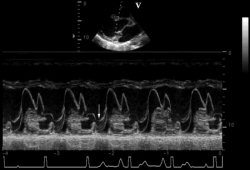Summary
Definition
History and exam
Key diagnostic factors
- presence of risk factors
- dyspnoea on exertion
- decreased exercise tolerance
- lower extremity oedema
- holosystolic murmur
Other diagnostic factors
- fatigue
- displaced point of maximal impulse
- orthopnoea
- paroxysmal nocturnal dyspnoea
- palpitations
- diaphoresis
- pulmonary closure is louder than aortic closure
- S3 heart sound
- diminished S1 heart sound
Risk factors
- mitral valve prolapse
- history of rheumatic heart disease
- infective endocarditis
- history of cardiac trauma
- history of myocardial infarction
- history of congenital heart disease
- history of ischaemic heart disease
- left ventricular systolic dysfunction
- hypertrophic cardiomyopathy
- anorectic/dopaminergic drugs
- elevated systolic blood pressure
Diagnostic investigations
Investigations to consider
- flow convergence method or proximal isovelocity surface area
- colour Doppler flow
- transoesophageal echocardiogram
- cardiac catheterisation
- cardiac magnetic resonance imaging (CMR)
Treatment algorithm
Contributors
Authors
Prakash P. Punjabi, FRCS, FESC, MS, MCh, FCCP, FFSTEd, Diplomate NBE
Professor
National Heart and Lung Institute
Imperial College London
Consultant Cardiothoracic Surgeon
Department of Cardiothoracic Surgery
Hammersmith Hospital
Imperial College Healthcare NHS Trust
London
UK
Disclosures
PPP is an author of references cited in this topic. PPP declares that he has no competing interests.
Acknowledgements
Dr Prakash P. Punjabi would like to gratefully acknowledge Dr Samir Kapadia and Dr Mehdi H. Shishehbor, previous contributors to this topic.
Disclosures
SK and MHS declare that they have no competing interests.
Peer reviewers
Matthew Czarny, MD
Assistant Professor of Medicine
Department of Cardiovascular Medicine
Johns Hopkins University School of Medicine
Baltimore
MD
Disclosures
MC is a paid consultant to Medtronic and receives research grants to the institution as a site principal investigator for clinical trials for Medtronic, MedAlliance, and Abbott and a sub-investigator for clinical trials for Edwards Lifesciences. All of these companies manufacture devices used in the transcatheter treatment of structural heart and/or coronary artery disease.
Use of this content is subject to our disclaimer
